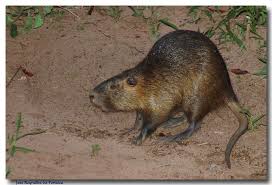Tuesday, January 18, 2011
Nutria
The nutria (Myocastor coypus) also known as the coypu, is a species of rodent found in South America. There are few populations which are domesticated. Their fur is used to make different accessories.
Physical Features
The nutria is like a ratlike animal with coarse fur. They have webbed feet and are more agile in water than on land. Nutrias have a body length of 43 to 62 cm (17 to 25 inches) and have a tail length of 43 cm (17 inches). They can weigh 17 kilograms at most. They have a very soft coat which is reddish brown. Their tail is very long and scaly with very less hair. Their underside is velvety. They have a large head with small eyes and large incisors which are orange in color. Only their hind feet are webbed.
Diet
Nutrias are omnivores. They are very fond of aquatic plants and roots. They may even eat small creatures like snails.
Distribution and Habitat
The nutria is native to South American countries like Bolivia, southern Brazil, Paraguay and Uruguay. They are introduced in many other places. Nutrias can be found in marshes, streams, slow flowing rivers and lakes.
Behavior
Nutrias are active in the day and night. They are semi-aquatic animals and are excellent swimmers and divers. They live in waterside burrows in small groups or pairs. They can be underwater for 5 minutes. Nutrias produce grunts, growls and squawks for communication.
Life Cycle
Female nutrias give birth to 2 or 3 litters with each consisting of 4 to 6 young. Females give birth to young ones in spring or summer after a gestation period of 4.5 months. The young are weaned at 1 to 8 weeks. Nutrias mature at the age of 3 or 7 months. They live for 7 years in captivity rarely live for more than 4 years in wild.
Population
Nutrias are abundant in South America. They are widely trapped for their precious fur. Their rapid growth of population is a problem for farmers as they are getting fond of crops grown by farmers. They are a serious nuisance outside their native range.
Source of picture 1:http://www.treknature.com/gallery/South_America/Brazil/photo124093.htm
Subscribe to:
Post Comments (Atom)

No comments:
Post a Comment